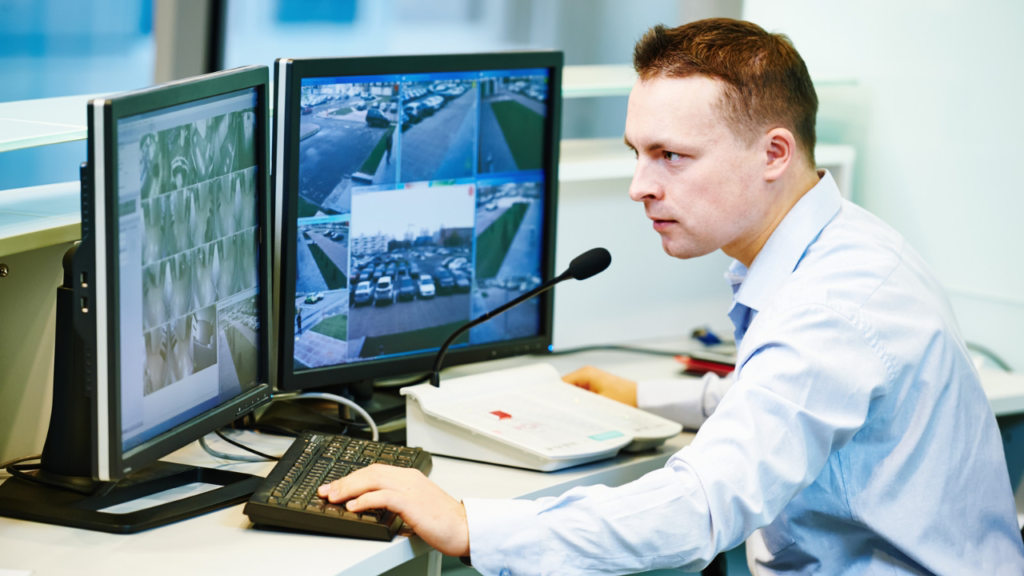In today’s digital age, security and surveillance systems have become a crucial aspect of ensuring the safety and protection of our homes, offices, and public spaces. One essential component of these systems is the monitor used to view the footage captured by security and CCTV cameras. Choosing the right monitor for your security camera is vital to ensure optimal viewing experience and accurate monitoring of your surroundings.
In this comprehensive guide, we will explore the key factors to consider when selecting a monitor for security and CCTV cameras. We will delve into the various aspects such as size, power usage, lifespan, resolution, panel types, refresh rates, response times, reflectivity, brightness, and BNC analog connection. By understanding these factors, you will be able to make an informed decision and find the best monitor that suits your specific security needs.

Key factors to consider when selecting a monitor for CCTV Setup.
Size
The size of the monitor is an important consideration as it directly impacts your experience. The optimal monitor size depends on factors such as your view distance, desired resolution, and the number of camera feeds you intend to view on one display. If you prefer to sit farther away from the monitor, a larger screen size is recommended to ensure clear visibility of all camera feeds. On the other hand, smaller monitors allow for more camera feeds to fit within your field of view without excessive eye movement. Additionally, larger monitors with higher resolutions enable you to have more camera feeds and other applications displayed simultaneously. The table below provides the optimal resolutions for different monitor sizes:
Monitor SizeOptimal Resolution24 inch1080p / 1440p27 inch1440p / 4K32 inch1440p / 4K42+ inch4KIt’s important to ensure that your CCTV DVR or security device can handle the higher resolution if you opt for a monitor with a resolution higher than the optimal range.
Power Usage
Power usage is another crucial factor to consider when selecting a monitor for security and CCTV cameras. LED-backlit monitors, which are the most common nowadays, generally consume an average of 45 to 65 watts during use. Energy Star certified monitors can use as little as 16 to 35 watts, but they may not be as brightly lit in energy-saving mode. Larger LED monitors or TVs (over 30 inches) may consume around 80 to 100 watts. It’s essential to balance power usage with the desired brightness level and image quality for your specific surveillance requirements.
Lifespan
The lifespan of a monitor is an important consideration, especially for security systems that require continuous monitoring. LED-backlit displays typically have a lifespan of around 100,000 hours, equivalent to 5 to 11 years of constant use. LCD backlit displays have a similar lifespan range of 50,000 to 100,000 hours. However, it’s important to note that the lifespan may vary depending on the quality of components and the operating temperature of the display. High-quality LED displays generally last up to the estimated lifespan, making them a reliable choice for long-term surveillance needs.
Burn-in
When selecting a monitor for CCTV cameras feeds, it’s crucial to consider the potential for burn-in, particularly with OLED displays. LED LCD monitors are less susceptible to screen burn-in compared to OLED displays. If you plan to use an OLED TV for your CCTV feed, there may be some minor burn-in over time. However, newer OLED models typically have settings and features to mitigate screen burn-in. It’s advisable to weigh the advantages and disadvantages of different display technologies based on your specific requirements.
Resolution
The resolution of the monitor plays a significant role in the clarity and detail of the camera footage displayed. Higher resolutions allow for a more detailed and crisp image, enhancing the viewing experience. Security cameras typically have resolutions of 1080p, 2K, or 4K. While the monitor resolution doesn’t need to match the exact camera resolution, it’s recommended to select a monitor that can provide clear visibility of the camera feed. For example, a 27-inch monitor with a 1440p resolution will look significantly crisper compared to a 1080p resolution. However, if you want to fully benefit from a 4K camera feed, it’s best to choose a 4K display, especially if you intend to view multiple camera feeds simultaneously on one display.
Panel Types
The panel type of a monitor affects various aspects such as color accuracy, viewing angles, and response times. Common LCD panel types include TN (Twisted Nematic), VA (Vertical Alignment), and IPS (In-Plane Switching). Each panel type has its advantages and disadvantages, and the choice depends on your specific requirements and budget.
- TN panels offer excellent response times and high refresh rates, making them suitable for fast-paced gaming and responsive applications. However, they generally have narrower viewing angles and inferior color reproduction compared to IPS panels.
- VA panels provide better contrast ratios and deeper blacks than TN or IPS panels. They offer wider viewing angles than TN panels but may still fall short of IPS panels in terms of color accuracy and view angles.
- IPS panels are known for their superior color accuracy, wide angles, and consistent image quality. They are ideal for applications that require precise color reproduction and accurate image representation. However, IPS panels may have slightly higher response times compared to TN panels.

Refresh Rates
Refresh rate is the number of times a monitor can redraw the screen per second and is measured in hertz (Hz). Higher refresh rates result in smoother motion and reduced motion blur, making them beneficial for fast-paced content and gaming. However, for viewing security camera feeds, refresh rates are less critical as there is typically minimal motion involved. A refresh rate of 60 Hz is sufficient for security camera monitoring purposes. Monitors with refresh rates ranging from 75 Hz to 165 Hz are recommended for general use, including multitasking and browsing.
Response Times
Response time refers to the time it takes for a monitor pixel to transition from one color to another. A lower response time results in reduced motion blur and smoother visuals, making it important for applications that involve fast-moving content. For security camera monitoring, a response time of 1 ms is ideal for optimal clarity and minimal ghosting. Monitors with slightly higher response times, such as 5 ms, can still give a satisfactory viewing experience if minor ghosting is tolerable.
Reflectivity
The reflectivity of a monitor influences its visibility in different lighting conditions. In brightly lit environments or with lights shining from behind, a glossy and reflective monitor may hinder visibility by causing glare and reflections on the screen. For optimal viewing in such conditions, it’s recommended to choose a monitor with an anti-glare panel. Anti-glare panels minimize reflections and give clear visibility even in brightly lit spaces.
Brightness
The brightness level of a monitor is measured in candela per square meter (cd/m²) and determines the screen’s luminosity. Most monitors sold today have a brightness range of 250 to 350 cd/m², which is suitable for general use and security camera monitoring. Brighter monitors with a range of around 500 cd/m² are better suited for brightly lit environments or when a brighter screen is desired. It’s important to note that turning off energy-saving settings and adjusting the brightness level can maximize the supported brightness of the monitor.
BNC Analog Connection
Some security cameras use BNC analog connections, which require specific monitor compatibility. Monitors with BNC inputs allow direct connection to analog cameras, but they are usually smaller in size and may not support higher resolutions, refresh rates, and response times. If you require BNC inputs, you can explore monitors specifically designed for this purpose. Alternatively, you can use a receiver to connect your analog cameras and then connect the receiver to a monitor via HDMI. This provides more flexibility in choosing a monitor without specific BNC inputs.
Now that we have explored the various factors to consider when selecting a monitor for security and CCTV cameras, let’s move on to our recommendations for the best monitors and TVs for viewing security and CCTV camera feeds.

Monitors for Viewing Security and CCTV Camera Feeds
- SAMSUNG UJ59 Series 32-Inch 4K Computer Monitor (LU32J590UQNXZA): With its 4K resolution and 32-inch screen size, this monitor allows for optimal viewing of security camera feeds. It supports one billion colors, picture-in-picture, and offers VESA mounting options. Check Price on Amazon
- BenQ EX2780Q 27-Inch 1440p Monitor: Featuring a 1440p resolution, 144 Hz refresh rate, and IPS panel, this monitor offers excellent picture quality and smooth motion handling. It also includes features like optimization for on-screen content and ambient light. Check Price on Amazon
- ASUS ProArt PA278QV 27-Inch 1440p Monitor: This monitor is factory calibrated for color accuracy, offering 100% sRGB and 100% Rec. 709 color gamut. It supports portrait orientation, VESA mounting, and features an IPS panel for excellent image quality. Check Price on Amazon
Recommended TVs for Viewing Security and CCTV Camera Feeds
- Samsung QN90A QLED TV (2021 Model): With its QLED technology, this TV offers vibrant colors, deep blacks, and excellent contrast ratios. It features a high refresh rate and supports various smart features for a comprehensive viewing experience. Check Price on Amazon
- LG C1 OLED TV (2021 Model): OLED technology provides deep blacks and excellent color accuracy, making this TV ideal for security camera feeds. It offers a high refresh rate, supports HDMI 2.1 for gaming, and features smart TV capabilities. Check Price on Amazon
- Sony X90J LED TV (2021 Model): This LED TV offers excellent picture quality, high brightness levels, and a wide color gamut. It supports HDMI 2.1, has a high refresh rate, and features smart TV functionality for seamless integration with your security system. Check Price on Amazon
By considering the factors mentioned above and exploring our recommended monitors and TVs, you can confidently select the best option for your security and CCTV cameras. Remember to choose a monitor or TV that offers the optimal combination of size, resolution, panel type, and other features that align with your specific surveillance needs. With the right monitor, you can enhance your monitoring capabilities and ensure the safety and security of your premises.


